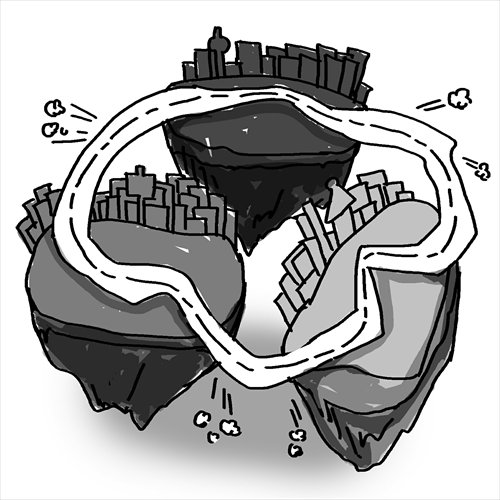HOME >> BUSINESS
New road must accelerate sustainable integration
By Chu Daye Source:Global Times Published: 2014-7-1 17:08:01
Hebei highway project could veer toward trouble without careful planning

Illustration: Lu Ting/GT
Five years after Beijing's 188-kilometer-long Sixth Ring Road was commissioned, authorities in Hebei Province unveiled plans last week to complete a 940-kilometer highway - known as Beijing's Seventh Ring Road - by 2015.
The area encircled by the new road will be larger than Belgium, reports say.
The new highway, which will have 90 percent of its length in Hebei Province, is designed to reduce transportation times between major cities in the Beijing-Tianjin-Hebei development area to within one hour, according to planners. Similarly, transportation times between major and smaller cities will be shortened to within half an hour.
Many Chinese people are familiar with the idea that making a fortune starts with building good roads. No one can deny the benefits that an enhanced regional transportation network will bring. But we should be aware of the possible negative repercussions of this new highway, particularly in terms of the original goals that were first set for the Beijing-Tianjin-Hebei development area.
The integration of Beijing, Tianjin and Hebei Province is a notion that existed long before it was thrust to the top of the national agenda on February 26 by President Xi Jinping. This bloc is expected to enhance regional coordination on a host of economic and environmental issues. In fact, the central government is championing this bloc now as a way to relieve pressure on Beijing. China's capital city is home to over 21 million permanent residents, and continued urbanization in and around Beijing is straining resources and the local environment. Perhaps nowhere is that more apparent than the city's traffic-choked roads.
A recent study revealed that automobile exhaust accounts for about 30 percent of the PM2.5 pollution in Beijing's air at any given time. Moreover, about 30 percent of this exhaust gets spewed from vehicles registered outside of Beijing. It is believed that many of these non-local automobiles are just passing through due to the city's position as a major transportation hub.
Will the Seventh Ring Road truly help to divert traffic away from Beijing as transportation authorities claim? For now, we cannot know for sure. If traffic flow volume in this region remains unchanged, we could perhaps look forward to less congestion in the capital.
In reality, the reverse could just as easily prove true. The newest ring road may perhaps offer a compelling incentive for millions of rural and suburban households in the region to purchase their first automobile. A spike in car ownership would only exacerbate the current exhaust problem.
Even if private car ownership holds steady, we can still expect a rise in heavy commercial vehicle traffic. Simply moving these vehicles a few dozen kilometers away from their current routes will do little to improve air quality in the region, since dust and pollutants from exhaust can travel long distances once they enter the local atmosphere.
Whether authorities in Hebei Province charge tolls on this new road will also impact traffic. Beijing's Sixth Ring Road is seen by many as a failure in terms of steering traffic away from the capital, since tolls are charged on this road and mindful drivers often hit the toll-free Fifth Ring Road instead to save money.
Hebei's many steel and cement makers could also live on if new road plans increase business. Right now many of these companies are struggling to survive amid slowing market demand and fierce competition caused by supply gluts. Keeping these long-suffering businesses afloat will preserve thousands of local jobs, but at the expense of industrial upgrading initiatives that are meant to serve the region's interests over the long term.
What's more, as large-scale infrastructure projects are often quickly conceived and executed, it seems likely that the Seventh Ring Road will take its design cues from economic factors rather than more subtle concerns about the region's cultural and ecological assets.
In a certain sense, the Seventh Ring Road can be seen as an offspring of Beijing's Second Ring Road, which was built on the ramparts of Beijing's time-honored city wall. Similarly, as a historically significant region in Chinese history, the Beijing-Tianjin-Hebei region is rich with historic sites and priceless archeological relics. As a giant ribbon of asphalt sweeps across the region, we must make sure that these treasures are protected.
Equally important, we must make sure the construction of the Seventh Ring Road does not threaten the forest belts painstakingly cultivated over recent years to protect Northern China from the advance of desert. In fact, planners should reinforce their road building efforts with an additional layer of forestation.
The creation of a Seventh Ring Road will strengthen economic integration and development around China's capital city. But planners must take precautions to make sure that progress on this front does not add to existing problems or create new ones.
The author is a reporter with the Global Times. bizopinion@globaltimes.com.cn
Posted in: Comments